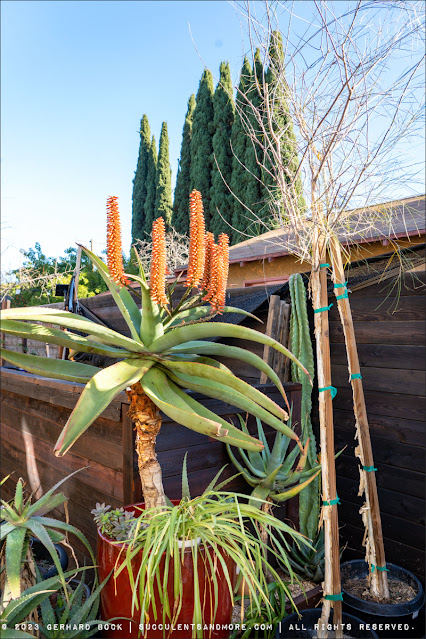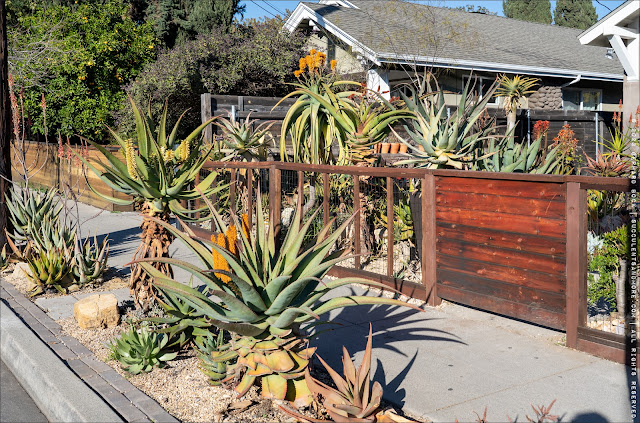My friend Danny goes by “Danny Aloehill” on social media. That’s a very a convenient handle because nobody needs to ask him what his favorite plants are (hint: not geraniums). Danny has one of the most comprehensive private aloe collections I know of, and I was finally able to see his garden when I drove to San Diego in February. Because of an unavoidable last-minute change of plans, Danny couldn’t be there, but he gave me permission to poke around as much as I wanted.
Danny lives on a small urban lot, not even 5000 sq.ft., but he has managed to squeeze an astounding variety of aloes into the front and the backyard. He’s been growing succulents and aloes for more than 15 years, but his collection really took off about 10 years ago when he moved into his current house and started this garden. A stint at the Huntington, where he worked in the Desert Garden, helped Danny expand his expertise.
 |
| Bungalow built in 1910 |
Currently, Danny has about 150 different aloe species. “My heart really lies with Mozambique endemics,” he said when I asked him which aloes he’s most interested in. “I do have a fascination with winter growing species that are most appropriate for coastal California’s Mediterranean climate.”
 |
| Fences are the norm in this neighborhood |
Another focus of Danny’s collection is the Aloe mawii complex: “It stole my heart 10 years ago and it’s still at the top of my list today—Aloe decurva, ribauensis, argentifolia, and mawii.”
 |
| The fence provides security but allows light into the garden |
 |
| Aloe thraskii |
 |
| Front: Aloe lukeana. Back (left to right): Aloe ferox, Aloe africana × excelsa, Aloe excelsa. |
 |
| Aloidendron ‘Hercules’ |
 |
| Aloidendron ‘Hercules’ |
 |
| Aloe broomii |
 |
| Aloe rivierei |
 |
| Aloe greatheadii var. davyana (aka Aloe verdoorniae) |
 |
| Cactus collection |
 |
| Cacti, agaves, and other small succulents |
While aloes make up the majority of the plants in Danny’s garden, he’s also fascinated with many California natives, in particular dudleyas. “It’s hard driving down our highways, hiking through our canyons, or even walking around neighborhoods and not noticing the iconic blue chalky plants,” he said.
 |
| Dudleya brittonii |
 |
| Aloe ankoberensis |
Walking around the side of the house towards the backyard:
 |
| Aloe volkensii ssp. multicaulis |
 |
| Aloe helenae, Aloe decurva |
 |
| Aloe angelica |
 |
| Aloe candelabrum, considered by many to be just a form of Aloe ferox |
 |
| Caesalpinia cacalaco (tall shrub in the back), Aloe powysiorum (front) |
 |
| Wider view of the back of the house |
 |
| Separate cottage (formerly a garage) in the backyard. The tall aloe in front is Aloidendron barberae. |
 |
| Aloe broomii × africana |
 |
| Front (left to right): Aloe tomentosa and Aloe speciosa × plicatilis. Back: Aloe africana × vanbalenii |
 |
| Left to right: Aloe aculeata (in half barrel), Aloe (mawii × munchii) × capitata cv. ‘Blood Moon’ (hybrid by Nick Deinhart), Aloe decurva, Aloe suzannae |
 |
| Front left to right: Aloe tauri, Aloe betsileensis hybrid, Aloe purpurea |
And finally a look at some of the aloes planted in the hell strip between the sidewalk and the street:
 |
| Aloe ferox hybrid |
 |
| Aloe littoralis |
 |
| Yellow-flowering Aloe candelabrum |
The plants along the sidewalk beautify the neighborhood, but they’re not protected against theft or vandalism. This is something I’m all to familiar with, since the sidewalk bed in our garden is just as exposed. Like me, Danny’s had plants stolen, and like me, he tries to rise above it: “I enjoy growing and sharing my garden with others so I wont let it discourage me.”
Another thing Danny and I have in common: We’re constantly bumping against the space limitations of our respective properties. Asked if he ever worries about running out of room, he quipped, “That thought haunts me every night.”
Other gardeners may worry about weeds and pests—and Danny and I do, too. But our main worry really is that we will never be able to have all the plants we love in our (current) gardens because there simply isn't enough space.
© Gerhard Bock, 2023. All rights reserved. To receive all new posts by email, please subscribe here.










































A fabulous collection. The Dudleya brittonii is absolute perfection!
ReplyDeleteThat amount of plants we love is without limit and constantly grows, which means not garden will ever be large enough to contain all our loves :-D
Chavli
What a beautiful garden. The Aloe broomii x africana looks positively edible. I'm sure this is the highlight of the neighborhood!
ReplyDeleteWell that was fun. It's nice to see a gardener so at home in his climate.
ReplyDeleteFantastic garden and great capture in both film and words. Thank you.
ReplyDeleteBeautiful work 👏👏👏 zzen321
ReplyDeleteThat's an impressive collection. It's too bad that the US doesn't have plant heritage members as Danny could be on the road to securing the national collection of Aloes here. A stint at the Huntington working in a garden area of strong interest has to be the holy grail of volunteer and/or internship assignments.
ReplyDeleteI really enjoyed the tour through Danny's garden. You did a beautiful job of photographing all those interesting plants.
ReplyDeleteSpectacular collection Danny - well done
ReplyDeleteFantastic collection or plants and they are quite artfully arranged so the garden doesn't look crammed. I chuckled at the comment 'haunted I will run of space' as it doesn't seem to matter how large your garden is there is always that fear.
ReplyDeleteWhat a pleasure seeing Danny's garden through your description and photographs. Thanks so much!
ReplyDeleteEnjoying the pictures - do you happen to have any aloe ferox pics without the skirt ?
ReplyDeleteI wondered if there is a reason on the Aloidendron ‘Hercules’ that the leaves are cut up and some of the cut ends are still attached to the trunk of the plant. I have never seen that before.
ReplyDelete